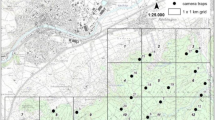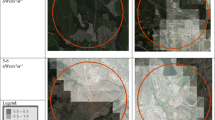Abstract
Previous research on the habituation of the crab Chasmagnathus granulatus to an iterated visual danger stimulus disclosed two remarkable features of this mnemonic process: a) the ready acquisition and long-lasting nature of the habituated response, and b) the likely endogenous opioid modulation of the shortterm habituation, whose potential adaptive value was studied here. Both the habituation ability and the opioid modulation of such ability were analysed in Chasmagnathus granulatus and Pachygrapsus marmoratus, two closely related grapsid species that diverge widely in ecology. Results indicate that Chasmagnathus has a much greater capacity to habituate than Pachygrapsus, showing a more pronounced short-term habituation which seems to some extent mediated by an endogenous opioid mechanism, and a faster acquisition of a greater longterm habituation partially mediated by memorial representation of the contextual cues. A correlation between these differences and those related with the ecological pressure was discussed. The capacity of acquiring longterm habituation in crabs of the same species but different age was also assessed, showing that old animals clearly exhibit lower retention of the habituated response than young crabs. The possible correlation between this age-dependent change and an ontogenetic shift of habitat was discussed.
Similar content being viewed by others
References
Alford RA (1989) Variation in predator phenology affects predator performance and prey community composition. Ecology 70:206–219
Balderrama N, Maldonado H (1973) Ontogeny of the behavior in the praying mantis. J Insect Physiol 19:319–336
Bond-Buckup G, Ferreira-Fontoura N, Possa-Marroni N, Kucharski LC (1991) O caranguejo. Editora da Universidade, Porto Alegre, RS, Brasil
Botto JL, Yrigoyen HR (1979) Bioecologia de la comunidad del cangrejal. I. Contribucion al conocimiento biologico del Cangrejo de Estuario, Chasmagnathus granulata Dana (Crustacea, Decapoda, Grapsidae), en la desembocadura del Rio Salado, Pcia. de Buenos Aires. In: UNESCO (ed) Memorias del seminario sobre ecologia bentonica y sedimentacion de la plataforma continental del Atlantico Sur. UNESCO, Montevideo, pp 161–169
Broekhuysen GJ (1936) On development, growth and distribution of Carcinus maenas (Linné). Arch Néerland Zool 2:257–399
Broekhuysen GJ (1941) The life-history of Cyclograpsus punctatus (M. Edw): breeding and growth. R Soc S Afr, Cape Town, Trans 28:331–366
Brunner D, Maldonado H (1988) Habituation in the crab Chasmagnathus granulatus: effect of morphine and naloxone. J Comp Physiol A 162:687–694
Cady WG (1964) Piezoelectricity. Dover, New York
Campbell BA, Jaynes J (1966) Reinstatement. Psychol Rev 73:478–480
Carew TJ, Kupfermann I (1974) The influence of different natural environments on habituation in Aplysia californica. Behav Biol 12:339–345
Charmantier-Daures M (1987) Transplantations croisées d'organes y chez des crabes jeunes et agés de l'espèce Pachygrapsus marmoratus (Crustacé, Décapode, Brachyoure). Bull Soc Zool Fr 103:43–46
Chichery MP, Chichery R (1992) Behavioral and neurohistological changes in aging Sepia. Brain Res 574:77–84
Clark RB (1960a) Habituation of the polychaete Nereis to sudden stimuli. I. General properties of the habituation process. Anim Behav 8:82–91
Clark RB (1960b) Habituation of the polychaete Nereis to sudden stimuli. 2. Biological significance of habituation. Anim Behav 8:92–103
Cullen E (1957) Adaptations in the kittiwake to cliff-nesting. Ibis
Davis M, File SE (1984) Intrinsic and extrinsic mechanisms of habituation and sensitization: implications for the design and analysis of experiments. In: Peeke HVS, Petrinovich L (eds) Habituation, sensitization and behavior. Academic Press, New York, pp 287–323
Dimant B, Maldonado H (1992) Habituation and associative learning during exploratory behavior of the crab Chasmagnathus. J Comp Physiol A 170:749–759
Domjan M, Galef B (1983) Biological constraints on instrumental and classical conditioning: retrospect and prospect. Anim Learn Behav 11:151–161
Falls JB (1969) Functions of territorial song in the white-throated sparrow. 1. In: Hinde RA (ed) Bird vocalizations. Their relation to current problems in biology and psychology. Cambridge University Press, London, pp 207–232
Fanselow MS, Calcagnetti DJ, Helmstetter FJ (1988) Delta opioid antagonist, 16-Me cyprenorphine, selectively attenuates conditional fearand DPDPE-induced analgesia on the formalin test. Pharmacol Biochem Behav 32:469–473
Fantino E, Logan CA (1979) The experimental analysis of behavior. WH Freeman and Co, San Francisco
Fernandez-Duque E, Vallegia C, Maldonado H (1992) Multitrial inhibitory avoidance learning in the crab Chasmagnathus. Behav Neural Biol 57:189–197
Hale EB, Almquist JO (1960) Relaxation of sexual behavior to germ cell output in farm animals. J Dairy Sci 43:145–169
Hall G, Honey RC (1989) Contextual effects in conditioning, latent inhibition, and habituation: associative and retrieval functions of contextual cues. J Exp Psychol: Anim Behav Proc 15:232–241
Harris JD (1943) Habituatory response decrement in the intact organism. Psychol Bull 40:385–422
Hermitte G, Maldonado H (1992) Conditioned facilitatory modulation of the response to an aversive stimulus in the crab Chasmagnathus. Physiol Behav 51:17–25
Hiatt RW (1948) The biology of the lined shore crab, Pachygrapsus crassipes Randall. Pacific Science 2:135–213
Hinde RA (1970) Behavioural habituation. In: Horn G, Hinde RA (eds) Short-term changes in neural activity and behaviour. University Press, Cambridge, pp 1–40
Humphrey G (1933) The nature of learning. Harcourt Brace, New York
Innes DGL, Kavaliers M (1987) Opiates and deer mouse behavior: differences between island and mainland populations. Can J Zool 65:2504–2512
Jaros PP (1990) Enkephalins, biologically active neuropeptides in invertebrates, with special reference to Crustacea. In: Wiese K et al (eds) Frontiers in crustacean neurobiology. Birkhäuser, Berlin, pp 471–482
Kavaliers M (1988) Polymorphism in opioid modulation of the thermal responses of the land snail Cepea nemoralis. Can J Zool 67:2721–2724
Kavaliers M, Innes DGL (1987) Stress-induced opioid analgesia and activity in deer mice: sex and population differences. Brain Res 425:49–56
Kavaliers M, Tepperman FS (1988) Exposure to novelty odors induces opioid-mediated analgesia in the land snail, Cepea nemoralis. Behav Neural Biol 50:285–299
Lang F, Govind CK, Costello WJ, Green SI (1977) Developmental neuroethology: changes in escape and defensive behavior during growth of the lobster. Science 197:682–685
Lehner GFJ (1941) A study of the extinction of unconditioned reflexes. J Exp Psychol 29:435–456
Leslie FM (1987) Methods used for the study of opioid receptors. Pharmacol Rev 39:197–249
Lozada M, Romano A, Maldonado H (1988) Effect of morphine and naloxone on a defensive response of the crab Chasmagnathus granulatus. Pharmacol Biochem Behav 30:635–640
Lozada M, Romano A, Maldonado H (1990) Long-term habituation to a danger stimulus in the crab Chasmagnathus granulatus. Physiol Behav 47:35–41
McKay DCG (1942) The Pacific edible crab Cancer magister. Fish Res Bd Can 62:1–32
Maldonado H, Romano A, Lozada M (1989) Opioid action on response level to a danger stimulus in the crab Chasmagnathus granulatus. Behav Neurosci 103:1139–1143
Marlin NA, Miller RR (1981) Associations to contextual stimuli as a determinant of long-term habituation. J Exp Psychol: Anim Behav Proc 7:313–333
Megela AL, Teyler TJ (1979) Habituation and the human evoked potential. J Comp Physiol Psychol 93:1154–1170
Morse DH (1980) Behavioral mechanisms in ecology. Harvard University Press, Cambridge, Mass., USA
Moskowitz AS, Terman GW, Liebeskind JC (1985) Stress-induced analgesia in the mouse: strain comparisons. Pain 23:67–72
Nicol JAC (1950) Responses of Branchioma vesiculosum (Montagu) to photic stimulation. J Mar Biol Assoc UK 29:303–320
Oliverio A, Castellano C, Puglisi-Allegra S (1983) Psychopharmacogenetics of opioids. Trends Pharmacol Sci 4:350–353
Olivier SR, Escofet AM, Penchaszadeh P, Orensanz MJ (1968) Estudio ecologico de la region estuarial de Mar Chiquita, Buenos Aires, Argentina. 1. Las comunidades bentonicas. Anal Soc Cient Argentina 193:237–262
Panocaka I, Marek P, Sadowski B (1986) Inheritance of stressinduced analgesia in mice: selective breeding study. Brain Res 397:152–155
Peeke HVS (1984) Habituation and the maintenance of territorial boundaries. In: Peeke HVS, Petrinovich L (eds) Habituation, sensitization, and behavior. Academic Press, New York, pp 393–421
Peeke HVS, Wyers EJ, Herz MJ (1969) Waning of the aggressive response to male models in the three-spined stickleback (Gasterosteus aculeatus). Anim Behav 17:224–228
Petrinovich L, Widaman KF (1984) An evaluation of statistical strategies to analyze repeated-measures data. In: Peeke HVS, Petrinovich L (eds) Habituation, sensitization, and behavior. Academic Press, New York, pp 155–201
Rakitin A, Tomsic D, Maldonado H (1991) Habituation and sensitization to an electrical shock in the crab Chasmagnathus. Effect of background illumination. Physiol Behav 50:477–487
Rescorla RA (1988) Behavioral studies of Pavlovian conditioning. Annu Rev Neurosci 1:329–352
Richards RA (1992) Habitat selection and predator avoidance: ontogenic shifts in habitat use by the Jonah crab Cancer borealis (Stimpson). J Exp Mar Biol Ecol 156:187–197
Romano A, Lozada M, Maldonado H (1990) Effect of naloxone pretreatment on habituation in the crab Chasmagnathus granulatus. Behav Neural Biology 53:113–122
Romano A, Lozada M, Maldonado H (1991) Non-habituation processes affect stimulus specificity of the response-habituation in the crab Chasmagnathus. Behav Neurosci 105:542–552
Shalter MD (1984) Predator-prey behavior and habituation. In: Peeke HVS, Petrinovich L (eds) Habituation, sensitization, and behavior. Academic Press, New York, pp 349–391
Tomsic D, Maldonado H (1990) Central effect of morphine pretreatment on shortand long-term habituation to a danger stimulus in the crab Chasmagnathus. Pharmacol Biochem Behav 36:787–793
Tomsic D, Maldonado H, Rakitin A (1991) Morphine and GABA: effects on perception, escape response and long-term habituation to a danger stimulus in the crab Chasmagnathus. Brain Res Bull 26:699–706
Valeggia C, Fernandez Duque E, Maldonado H (1989) Danger stimulus-induced analgesia in the crab Chasmagnathus granulatus. Brain Res 481:304–308
Werner EE, Gilliam JF (1984) The ontogenic niche and species interactions in size-structured populations. Annu Rev Ecol Syst 15:393–425
Zeil J, Nalbach G, Nalbach HO (1986) Eyes, eye-stalks and the visual world of semi-terrestrial crabs. J Comp Physiol A 159:801–811
Author information
Authors and Affiliations
Rights and permissions
About this article
Cite this article
Tomsic, D., Massoni, V. & Maldonado, H. Habituation to a danger stimulus in two semiterrestrial crabs: ontogenic, ecological and opioid modulation correlates. J Comp Physiol A 173, 621–633 (1993). https://doi.org/10.1007/BF00197770
Accepted:
Issue Date:
DOI: https://doi.org/10.1007/BF00197770




